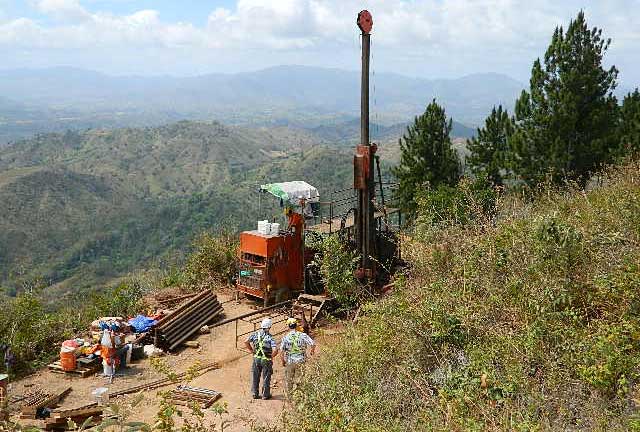Pershimco Resources’ (TSXV: PRO; US-OTC: RSPRF) Cerro Quema gold project in southwestern Panama is on track to start production in late 2016, and in its first full year of operation, it could be the Central American country’s largest exporter, president and CEO Alain Bureau tells The Northern Miner.
The wholly owned heap-leach project on the Azuero Peninsula is 150 km south of First Quantum Minerals’ (TSX: FM; LSE: FQM) Cobre Panama project, and 45 km southwest of the city of Chitre.
A July 2014 prefeasibility study outlined two main oxide pits — La Pava and Quema — that would produce a total of 417,800 oz. gold over a five-year mine life, at total operating costs of US$574 per oz. and all-in-sustaining costs of US$631 per oz. Total capex is estimated at US$107 million, with another US$10 million earmarked for heavy equipment.
Since the prefeasibility study wrapped up in July 2014 Pershimco has reached a number of milestones. In September 2014, it reduced its total net smelter return royalty (NSR) from 4.6% to 4%. (The company repurchased a 0.6% NSR related to future gold and silver production, as well as a 1.1% royalty on copper and all other mineral production from its concessions, leaving only the government royalty.)
In November, the junior acquired all surface rights defined within its environmental and social impact study (ESIA), and covering the 10,000-ton-per-day (9,072-tonne-per-day) gold oxide plant. In January 2015, it filed the ESIA with Panama’s environmental authorities.
So far, most of Pershimco’s activity on the 150 sq. km property has focused on the La Pava and Quemita deposits, shallow drilling on the two ridges and reserve building (488,000 oz. from 19.7 million tonnes grading 0.77 gram gold per tonne).
But CEO Bureau says there is lots of exploration upside. The company sees resource expansion potential in over 12 oxide targets identified along a 17 km trend, as well as porphyry indicators along a 12 km strike length that it believes suggests a copper-gold porphyry system could be at depth.
A deep-drilling campaign at the Quema, La Pava and Idaida targets intercepted porphyry indicators below and next to the high-sulphidation system, which suggest a nearby porphyry-style intrusive, the company reported in August 2014.
“Numerous additional open pits will be added to the first two pits we included in the prefeasibility study,” Bureau says. “The Cerro Quema project offers the full ‘textbook’ package, with supergene intercepts right under the oxides of 102 metres of 1% copper and 0.6 gram gold per tonne, and primary mineralization of the high sulphidation system reporting spectacular copper-gold intercepts under Idaida, and also porphyry indicators at depth.”
Highlights from drilling at its Idaida target include a 73-metre intercept grading 1.8% copper and 0.25 gram gold per tonne, and 145 metres averaging 0.9% copper, 0.13 gram gold and 1.56 grams silver.
The company believes Cerro Quema offers similar geology to the Tujuh-Bukit project in Indonesia (formerly owned by Australia’s Intrepid Mines and now by a group of private investors), and the Timok project in Serbia, owned by Reservoir Minerals (TSXV: RMC; US-OTC: RVRLF) and Freeport McMoRan (NYSE: FCX).
The company plans to fully finance exploration from its gold-oxide cash flow. “The project has lots of upside along the gold oxide corridors we have already tested,” Bureau says, adding that “we still have to complete the drilling on the western extension of La Pava,” and “a lot of drilling is still required on Quema hill in order to bring it into the initial open pit.”
Initial results released in January from reconnaissance exploration also uncovered a 7 km long mineralized trend of porphyry-style copper-gold-molybdenum mineralization. “The new copper-gold-moly mineralization trend at Cerro Quema crosses the gold oxide corridor at the Quema deposit, which is also the highest topographic feature on our concession,” Bureau says. “The trend runs from one surface alteration — 2 km northwest of Quema hill — through Idaida hill toward a second intrusive coming out at surface, 4 km southeast of Quema hill.”
“The fact that we also have intense porphyry related indicators at depth under Quema and Idaida, plus a combination of spectacular copper drilling at Idaida along that corridor, solidifies our model. These latest results triggered a lot of attention from major mining companies during our core shack at the recent Prospectors & Developers Association of Canada convention.”
Bureau says the company has “barely touched the eastern half of the concession,” and estimates that his team could finish the first pass of geochemical, stream sediment and mapping over the entire 15,000-hectare (150 sq. km) land package before year-end. (It has completed 70% of on the western concession.)
All of Pershimco’s major shareholders have remained with the company since the beginning of their investment, and “like to participate in financings to keep their position — an important sign that we do things right,” Bureau says. Agnico Eagle Mines (TSX: AEM; NYSE: AEM) holds a 17.8% interest, and the Sentient Group, 19.8%. Other shareholders include Sentry Select, Mackenzie Investments and RBC Asset Management.
As far as operating in Panama, Bureau says the government is “working seriously on being an attractive mining jurisdiction,” and boasts growing transportation infrastructure, a low crime rate and a good banking system, in addition to being “one of the fastest growing economies in the world.” Panama also has a “large pool of qualified labour, from heavy machinery operators and welders to mechanics and civil engineers.”
The corporate tax rate stands at 25%, and a 4% royalty is applied to precious metals and a 5% royalty on base metals, “making the jurisdiction comfortable to work in,” he adds, and in terms of geology, “hosts some of the largest undeveloped porphyries on the planet.”
The junior has 223 million shares outstanding and a $47-million market capitalization.


Be the first to comment on "Pershimco advances Cerro Quema in Panama"